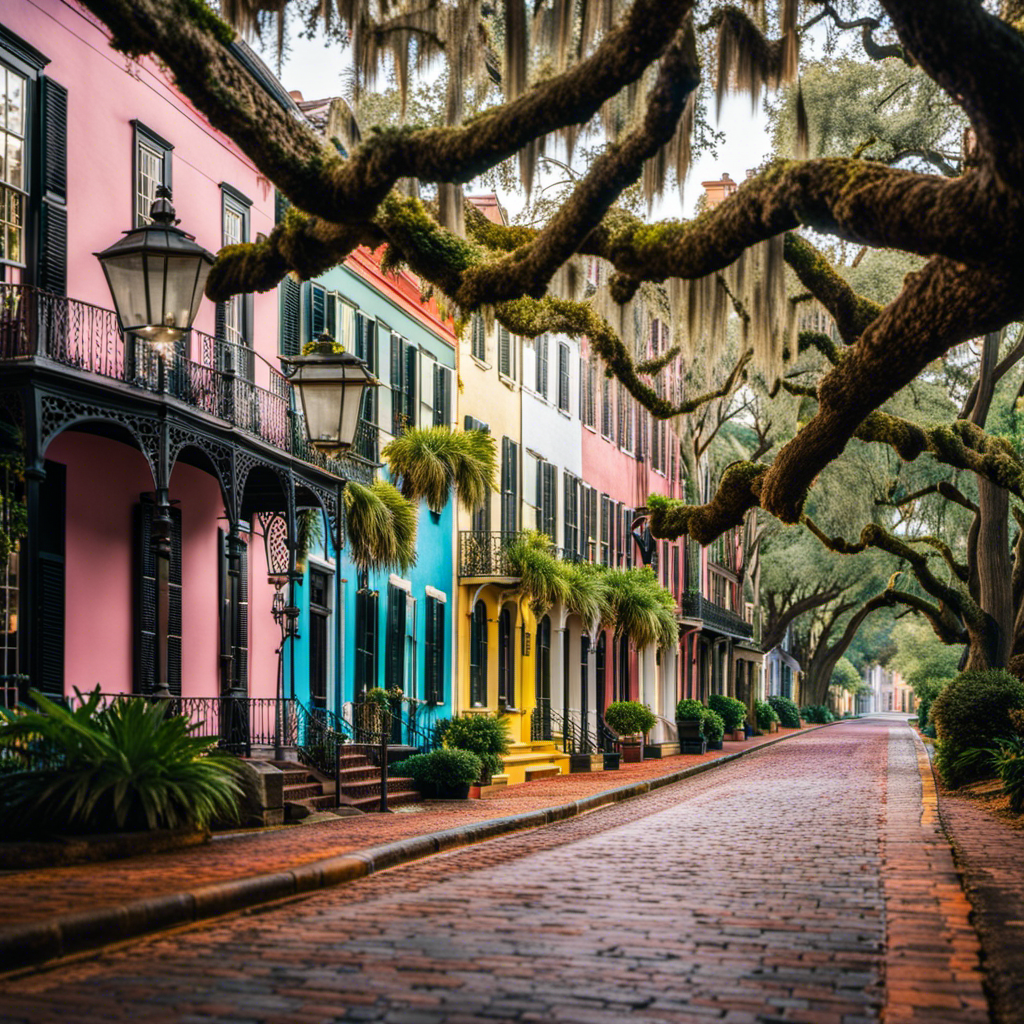As I stroll around Charleston, South Carolina, I feel transported to an era filled with deep history and hidden treasures.
Battery Park and White Point Garden offer a glimpse into the past with their antebellum architecture and remnants of American Revolution forts.
A tour of Fort Sumter takes me back to where the Civil War began, immersing me in the events that shaped our nation.
At Boone Hall Plantation, I delve into centuries of change and learn about the vibrant Gullah culture.
The Market, a bustling hub for over two centuries, showcases local art and handwoven baskets from the Gullah community.
Finally, I embark on a journey through Charleston’s port city history, unraveling the development of the American South.
Get ready to explore Charleston’s captivating historic landmarks and vibrant local treasures.
Key Takeaways
- Battery Park and White Point Garden offer a combination of rich history and picturesque landscapes, showcasing rare antebellum architecture and providing a serene atmosphere.
- Fort Sumter holds great historical significance as the place where the Civil War began, offering a half-hour cruise to the island, providing historical insights through guides and narrators, and allowing visitors to walk in the footsteps of those who fought.
- Boone Hall Plantation delves into the Gullah culture and sheds light on the lives of enslaved African-Americans, showcasing centuries of change and featuring a tranquil butterfly garden.
- The Market in Charleston, with its rich history since 1790, offers vibrant local art, unique gift items, and handwoven baskets from the Gullah community, supporting local artisans and celebrating the Gullah culture.
Battery Park and White Point Garden
I’ll definitely make sure to visit Battery Park and White Point Garden during my trip to Charleston. These two locations not only offer beautiful scenery but also hold immense historical significance.
Battery Park has played a crucial role in Charleston’s history, serving as home to two forts during the American Revolution and acting as a defense against English and Union soldiers. As I explore the area, I’ll be captivated by the rare antebellum architecture that reflects the city’s past.
Just a short distance away, White Point Garden awaits with its picturesque landscapes and serene atmosphere. It’s the perfect spot to take a leisurely stroll and soak in the history surrounding me.
From the stunning views to the rich historical background, Battery Park and White Point Garden are must-visit destinations in Charleston.
Fort Sumter
Board the ferry at Liberty Square downtown to start the tour of Fort Sumter. As I step onto the boat, excitement fills the air. We embark on a half-hour cruise, gliding through the waters towards the island where the Civil War began.
The guides and narrators on board provide fascinating historical insights, painting a vivid picture of the events that unfolded here. As we approach the island, the impressive fort comes into view, standing as a testament to the beginnings of the Civil War.
Stepping onto the island, I am transported back in time, walking in the footsteps of those who fought for their beliefs. The museum visit offers a deeper understanding of the conflict, before we board the ferry for a short cruise back, reflecting on the significance of Fort Sumter in American history.
Boone Hall Plantation
Built in the 1680s, Boone Hall Plantation showcases centuries of changes and offers a glimpse into the Gullah culture and African-American history. As I walked through the plantation, I was captivated by the rich heritage and stories that unfolded before me. Here are three highlights of my visit:
-
Gullah culture: The plantation provides a unique opportunity to learn about the Gullah culture, which has its roots in West Africa. From their language to their traditions, the Gullah people have played a significant role in shaping the history of the Lowcountry.
-
African-American history: Boone Hall Plantation not only showcases the grandeur of the antebellum era but also sheds light on the lives of enslaved African-Americans who worked and lived on the plantation. It is a powerful reminder of the struggles and resilience of a community.
-
Butterfly garden: Amidst the historical buildings and lush landscapes, I stumbled upon a breathtaking butterfly garden. It was a tranquil oasis filled with colorful flowers and fluttering butterflies, providing a peaceful escape and a chance to connect with nature.
Visiting Boone Hall Plantation was an eye-opening experience that left me with a deeper understanding and appreciation for the Gullah culture and African-American history.
Market Shopping
As I strolled through the Market in Charleston, I couldn’t help but be drawn to the vibrant local art and unique gift items that lined the stalls. The Market has been a part of Charleston’s history since 1790 and has served as the central market for residents for over two centuries.
It spans four city blocks with six structures, creating a bustling atmosphere filled with creativity. One of the highlights of the Market is the handwoven baskets from the Gullah community. These baskets are not just beautiful pieces of art, but they also represent the rich Gullah culture and traditions.
It’s fascinating to see the intricate designs and patterns that have been passed down through generations. Supporting local artisans at the Market is a wonderful way to appreciate and celebrate the Gullah culture while bringing home a piece of Charleston’s vibrant art scene.
Charleston’s Port City History
While exploring the vibrant city of Charleston, I was captivated by the rich history and development of this bustling port city. Charleston’s Port City History is a testament to the significance of the port in Charleston’s economy. The development of Charleston’s port played a crucial role in shaping the city’s growth and prosperity.
-
Development of Charleston’s Port:
-
The port of Charleston was established in 1670, making it one of the oldest ports in the United States.
-
Over the years, the port underwent significant development and expansion, becoming a major hub for trade and commerce.
-
Significance of Port City in Charleston’s Economy:
-
The port of Charleston has been instrumental in driving the local economy, attracting businesses and creating job opportunities.
-
It serves as a gateway for imports and exports, facilitating international trade and contributing to the city’s economic vitality.
Charleston’s port city history is a testament to the resilience and adaptability of this remarkable city, and its continued importance in the global economy.
Frequently Asked Questions
What Are the Admission Fees for Battery Park and White Point Garden?
The admission fees for Battery Park and White Point Garden are not mentioned in the Current Question. However, if you’re interested in exploring Charleston’s port city history, there are two-hour tours available.
Are Pets Allowed at Fort Sumter?
Yes, pets are allowed at Fort Sumter. You can bring your furry friend along as you tour the site where the Civil War began. It’s a fascinating historical experience for both you and your pet!
Can Visitors Participate in Any Hands-On Activities at Boone Hall Plantation?
Yes, visitors can participate in interactive experiences and educational workshops at Boone Hall Plantation. It’s a great opportunity to learn about the plantation’s history, Gullah culture, and even explore a working farm.
Are There Any Restaurants or Food Options Available at the Market?
Yes, there are plenty of food options at the Market. From local seafood to delicious Southern cuisine, dining establishments in the area offer a variety of mouthwatering dishes to satisfy any appetite.
How Long Are the Charleston Port City History Tours?
The Charleston Port City History Tours are a fascinating way to explore the city’s rich heritage. They offer insights into the historic architecture and cultural significance of Charleston. The tour duration varies, providing ample time to discover the city’s unique history.
Meet Asra, a talented and adventurous writer who infuses her passion for exploration into every word she writes. Asra’s love for storytelling and her insatiable curiosity about the world make her an invaluable asset to the Voyager Info team.
From a young age, Asra was drawn to the power of words and their ability to transport readers to far-off lands and magical realms. Her fascination with travel and cultures from around the globe fueled her desire to become a travel writer, and she set out on a journey to turn her dreams into reality.











